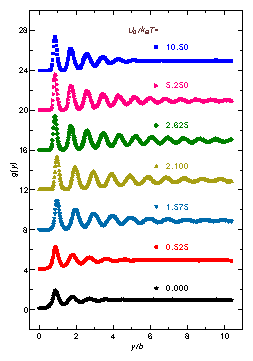 Figure 2:
(Color online). Averaged pair correlation functions g(y) in the y direction, parallel to the potential wells of 1DPS, for various depths of 1DPS, U0/kBT=0, 0.525, 1.575, 2.1, 2.625, 5.25, and 10.5, from bottom to top. The curves have been offset vertically for clarity. As the depth of the 1DPS U0 increases gradually from zero, the number of peaks in g(y) first increases, and then gradually decreases as the structure transitions from the initial disordered liquid state to an intermediate modulated order state, followed by a reentrant melting transition into a modulated disordered state.
Figure 2:
(Color online). Averaged pair correlation functions g(y) in the y direction, parallel to the potential wells of 1DPS, for various depths of 1DPS, U0/kBT=0, 0.525, 1.575, 2.1, 2.625, 5.25, and 10.5, from bottom to top. The curves have been offset vertically for clarity. As the depth of the 1DPS U0 increases gradually from zero, the number of peaks in g(y) first increases, and then gradually decreases as the structure transitions from the initial disordered liquid state to an intermediate modulated order state, followed by a reentrant melting transition into a modulated disordered state.
|

